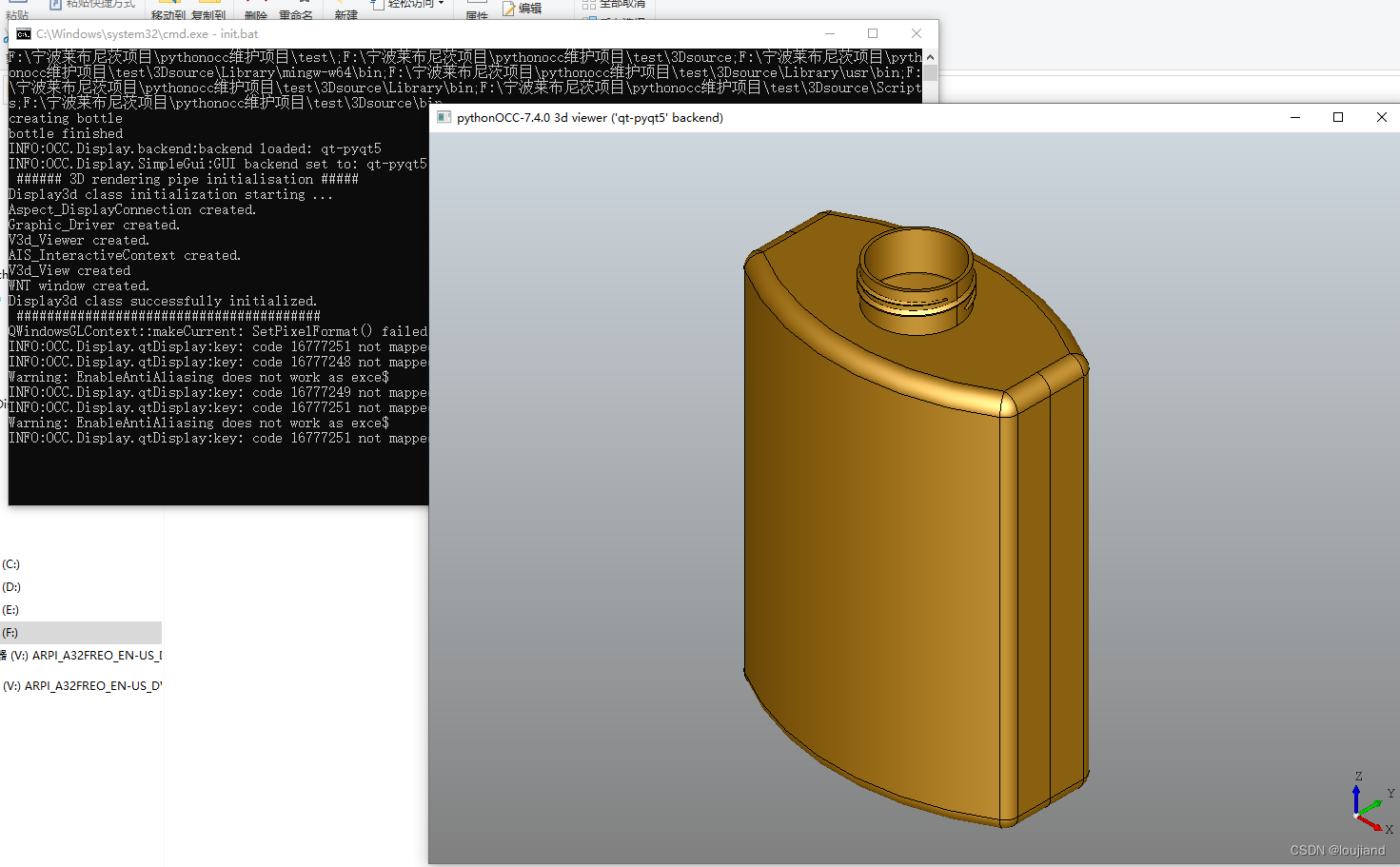一直以来,我们都是先通过anaconda安装pythonocc,然后在通过运行pycharm设置开发环境的方式来运行pythonocc的程序。但是我最近发现了pycharm也是通过设置环境变量以使得pythonocc程序得以运行。后来我观察出来他们是设置以下几个环境变量,于是我把他们写成了bat,通过此方法来运行pythonocc,结果肯定是成功的下面我将把过程和内容告诉大家。
需要设置的环境变量如下所示
C:\Users\Administrator\Anaconda3\envs\3Dsource;
C:\Users\Administrator\Anaconda3\envs\3Dsource\Library\mingw-w64\bin;
C:\Users\Administrator\Anaconda3\envs\3Dsource\Library\usr\bin;
C:\Users\Administrator\Anaconda3\envs\3Dsource\Library\bin;
C:\Users\Administrator\Anaconda3\envs\3Dsource\Scripts;
C:\Users\Administrator\Anaconda3\envs\3Dsource\bin;
C:\Users\Administrator\Anaconda3\condabin;
运行过程如下所述:
1.新建一个记事本取名为init.bat 里面内容如下
@echo off
cd /d %~dp0
rem 你自己安装anaconda目录来写
set path=C:\Users\Administrator\Anaconda3\envs
rem 你的pythonocc安装环境的名称
set parameter0=3Dsource
set parameter1=\Library\mingw-w64\bin
set parameter2=\Library\usr\bin
set parameter3=\Library\bin
set parameter4=\Scripts
set parameter5=\bin
set parameter6=\Lib\site-packages\PyQt5\Qt5\plugins\platforms
set path0=%path%%parameter0%
set path1=%path0%%parameter1%
set path2=%path0%%parameter2%
set path3=%path0%%parameter3%
set path4=%path0%%parameter4%
set path5=%path0%%parameter5%
set path6=%path0%%parameter6%
set PATH=%PATH%;%path0%
set PATH=%PATH%;%path1%
set PATH=%PATH%;%path2%
set PATH=%PATH%;%path3%
set PATH=%PATH%;%path4%
set PATH=%PATH%;%path5%
set QT_QPA_PLATFORM_PLUGIN_PATH=%path6%
echo %PATH%
python core_classic_occ_bottle.py
2.新建一个记事本取名为start.bat 里面内容如下
start init.bat
3.start.bat所在文件夹下 新建一个名字为core_classic_occ_bottle.py的python文件 其内容如下
#!/usr/bin/env python
##Copyright 2009-2015 Thomas Paviot (tpaviot@gmail.com)
##
##This file is part of pythonOCC.
##
##pythonOCC is free software: you can redistribute it and/or modify
##it under the terms of the GNU Lesser General Public License as published by
##the Free Software Foundation, either version 3 of the License, or
##(at your option) any later version.
##
##pythonOCC is distributed in the hope that it will be useful,
##but WITHOUT ANY WARRANTY; without even the implied warranty of
##MERCHANTABILITY or FITNESS FOR A PARTICULAR PURPOSE. See the
##GNU Lesser General Public License for more details.
##
##You should have received a copy of the GNU Lesser General Public License
##along with pythonOCC. If not, see <http://www.gnu.org/licenses/>.
import math
from OCC.Core.gp import (gp_Pnt, gp_OX, gp_Vec, gp_Trsf, gp_DZ, gp_Ax2, gp_Ax3,
gp_Pnt2d, gp_Dir2d, gp_Ax2d, gp_Pln)
from OCC.Core.GC import GC_MakeArcOfCircle, GC_MakeSegment
from OCC.Core.GCE2d import GCE2d_MakeSegment
from OCC.Core.Geom import Geom_CylindricalSurface
from OCC.Core.Geom2d import Geom2d_Ellipse, Geom2d_TrimmedCurve
from OCC.Core.BRepBuilderAPI import (BRepBuilderAPI_MakeEdge, BRepBuilderAPI_MakeWire,
BRepBuilderAPI_MakeFace, BRepBuilderAPI_Transform)
from OCC.Core.BRepPrimAPI import BRepPrimAPI_MakePrism, BRepPrimAPI_MakeCylinder
from OCC.Core.BRepFilletAPI import BRepFilletAPI_MakeFillet
from OCC.Core.BRepAlgoAPI import BRepAlgoAPI_Fuse
from OCC.Core.BRepOffsetAPI import BRepOffsetAPI_MakeThickSolid, BRepOffsetAPI_ThruSections
from OCC.Core.BRepLib import breplib
from OCC.Core.BRep import BRep_Builder
from OCC.Core.GeomAbs import GeomAbs_Plane
from OCC.Core.BRepAdaptor import BRepAdaptor_Surface
from OCC.Core.TopoDS import topods, TopoDS_Compound, TopoDS_Face
from OCC.Core.TopExp import TopExp_Explorer
from OCC.Core.TopAbs import TopAbs_EDGE, TopAbs_FACE
from OCC.Core.TopTools import TopTools_ListOfShape
def face_is_plane(face: TopoDS_Face) -> bool:
"""
Returns True if the TopoDS_Face is a plane, False otherwise
"""
surf = BRepAdaptor_Surface(face, True)
surf_type = surf.GetType()
return surf_type == GeomAbs_Plane
def geom_plane_from_face(aFace: TopoDS_Face) -> gp_Pln:
"""
Returns the geometric plane entity from a planar surface
"""
return BRepAdaptor_Surface(aFace, True).Plane()
height = 70
width = 50
thickness = 30
print("creating bottle")
# The points we'll use to create the profile of the bottle's body
aPnt1 = gp_Pnt(-width / 2.0, 0, 0)
aPnt2 = gp_Pnt(-width / 2.0, -thickness / 4.0, 0)
aPnt3 = gp_Pnt(0, -thickness / 2.0, 0)
aPnt4 = gp_Pnt(width / 2.0, -thickness / 4.0, 0)
aPnt5 = gp_Pnt(width / 2.0, 0, 0)
aArcOfCircle = GC_MakeArcOfCircle(aPnt2, aPnt3, aPnt4)
aSegment1 = GC_MakeSegment(aPnt1, aPnt2)
aSegment2 = GC_MakeSegment(aPnt4, aPnt5)
# Could also construct the line edges directly using the points instead of the resulting line
aEdge1 = BRepBuilderAPI_MakeEdge(aSegment1.Value())
aEdge2 = BRepBuilderAPI_MakeEdge(aArcOfCircle.Value())
aEdge3 = BRepBuilderAPI_MakeEdge(aSegment2.Value())
# Create a wire out of the edges
aWire = BRepBuilderAPI_MakeWire(aEdge1.Edge(), aEdge2.Edge(), aEdge3.Edge())
# Quick way to specify the X axis
xAxis = gp_OX()
# Set up the mirror
aTrsf = gp_Trsf()
aTrsf.SetMirror(xAxis)
# Apply the mirror transformation
aBRespTrsf = BRepBuilderAPI_Transform(aWire.Wire(), aTrsf)
# Get the mirrored shape back out of the transformation and convert back to a wire
aMirroredShape = aBRespTrsf.Shape()
# A wire instead of a generic shape now
aMirroredWire = topods.Wire(aMirroredShape)
# Combine the two constituent wires
mkWire = BRepBuilderAPI_MakeWire()
mkWire.Add(aWire.Wire())
mkWire.Add(aMirroredWire)
myWireProfile = mkWire.Wire()
# The face that we'll sweep to make the prism
myFaceProfile = BRepBuilderAPI_MakeFace(myWireProfile)
# We want to sweep the face along the Z axis to the height
aPrismVec = gp_Vec(0, 0, height)
myBody_step1 = BRepPrimAPI_MakePrism(myFaceProfile.Face(), aPrismVec)
# Add fillets to all edges through the explorer
mkFillet = BRepFilletAPI_MakeFillet(myBody_step1.Shape())
anEdgeExplorer = TopExp_Explorer(myBody_step1.Shape(), TopAbs_EDGE)
while anEdgeExplorer.More():
anEdge = topods.Edge(anEdgeExplorer.Current())
mkFillet.Add(thickness / 12.0, anEdge)
anEdgeExplorer.Next()
# Create the neck of the bottle
neckLocation = gp_Pnt(0, 0, height)
neckAxis = gp_DZ()
neckAx2 = gp_Ax2(neckLocation, neckAxis)
myNeckRadius = thickness / 4.0
myNeckHeight = height / 10.0
mkCylinder = BRepPrimAPI_MakeCylinder(neckAx2, myNeckRadius, myNeckHeight)
myBody_step2 = BRepAlgoAPI_Fuse(mkFillet.Shape(), mkCylinder.Shape())
# Our goal is to find the highest Z face and remove it
zMax = -1.
# We have to work our way through all the faces to find the highest Z face so we can remove it for the shell
aFaceExplorer = TopExp_Explorer(myBody_step2.Shape(), TopAbs_FACE)
while aFaceExplorer.More():
aFace = topods.Face(aFaceExplorer.Current())
if face_is_plane(aFace):
aPlane = geom_plane_from_face(aFace)
# We want the highest Z face, so compare this to the previous faces
aPntLoc = aPlane.Location()
aZ = aPntLoc.Z()
if aZ > zMax:
zMax = aZ
aFaceExplorer.Next()
facesToRemove = TopTools_ListOfShape()
facesToRemove.Append(aFace)
myBody_step3 = BRepOffsetAPI_MakeThickSolid(myBody_step2.Shape(), facesToRemove, -thickness / 50.0, 0.001)
# Set up our surfaces for the threading on the neck
neckAx2_Ax3 = gp_Ax3(neckLocation, gp_DZ())
aCyl1 = Geom_CylindricalSurface(neckAx2_Ax3, myNeckRadius * 0.99)
aCyl2 = Geom_CylindricalSurface(neckAx2_Ax3, myNeckRadius * 1.05)
# Set up the curves for the threads on the bottle's neck
aPnt = gp_Pnt2d(2.0 * math.pi, myNeckHeight / 2.0)
aDir = gp_Dir2d(2.0 * math.pi, myNeckHeight / 4.0)
anAx2d = gp_Ax2d(aPnt, aDir)
aMajor = 2.0 * math.pi
aMinor = myNeckHeight / 10.0
anEllipse1 = Geom2d_Ellipse(anAx2d, aMajor, aMinor)
anEllipse2 = Geom2d_Ellipse(anAx2d, aMajor, aMinor / 4.0)
anArc1 = Geom2d_TrimmedCurve(anEllipse1, 0, math.pi)
anArc2 = Geom2d_TrimmedCurve(anEllipse2, 0, math.pi)
anEllipsePnt1 = anEllipse1.Value(0)
anEllipsePnt2 = anEllipse1.Value(math.pi)
aSegment = GCE2d_MakeSegment(anEllipsePnt1, anEllipsePnt2)
# Build edges and wires for threading
anEdge1OnSurf1 = BRepBuilderAPI_MakeEdge(anArc1, aCyl1)
anEdge2OnSurf1 = BRepBuilderAPI_MakeEdge(aSegment.Value(), aCyl1)
anEdge1OnSurf2 = BRepBuilderAPI_MakeEdge(anArc2, aCyl2)
anEdge2OnSurf2 = BRepBuilderAPI_MakeEdge(aSegment.Value(), aCyl2)
threadingWire1 = BRepBuilderAPI_MakeWire(anEdge1OnSurf1.Edge(), anEdge2OnSurf1.Edge())
threadingWire2 = BRepBuilderAPI_MakeWire(anEdge1OnSurf2.Edge(), anEdge2OnSurf2.Edge())
# Compute the 3D representations of the edges/wires
breplib.BuildCurves3d(threadingWire1.Shape())
breplib.BuildCurves3d(threadingWire2.Shape())
# Create the surfaces of the threading
aTool = BRepOffsetAPI_ThruSections(True)
aTool.AddWire(threadingWire1.Wire())
aTool.AddWire(threadingWire2.Wire())
aTool.CheckCompatibility(False)
myThreading = aTool.Shape()
# Build the resulting compound
bottle = TopoDS_Compound()
aBuilder = BRep_Builder()
aBuilder.MakeCompound(bottle)
aBuilder.Add(bottle, myBody_step3.Shape())
aBuilder.Add(bottle, myThreading)
print("bottle finished")
if __name__ == "__main__":
from OCC.Display.SimpleGui import init_display
display, start_display, add_menu, add_function_to_menu = init_display()
display.DisplayShape(bottle, update=True)
start_display()
4.最后双击start.bat 就会出现如下画面

最后祝你们成功!






















 407
407











 被折叠的 条评论
为什么被折叠?
被折叠的 条评论
为什么被折叠?










